Simply put, Vangi Bath is a delicious spiced and tangy preparation that has ‘vangi’ (brinjal/eggplant/aubergine) and ‘bath’ (meaning rice). In simple words, call it brinjal rice or eggplant rice. Not just in Karnataka, a variation of this dish is also popular in Maharashtrian cuisine. Both these regional versions have their own unique taste as some of the ingredients and spices used are different for both. Here, I have shared the traditional and classic Vangi Bath recipe that is made in Karnataka.
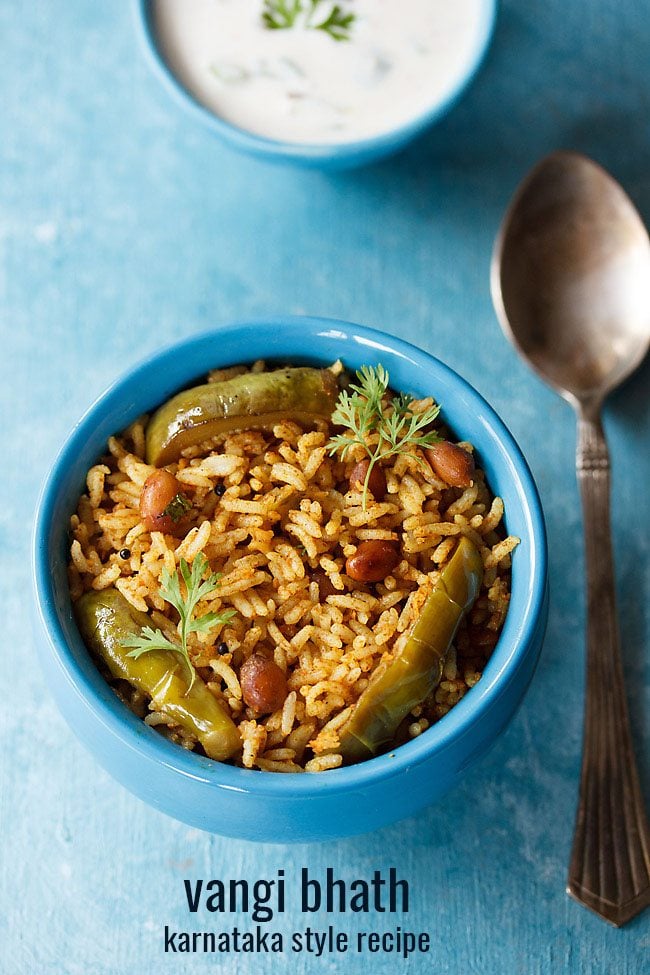
About Vangi Bath
The main ingredients in the Karnataka style Vangi Bath recipe are a special Vangi Bath masala powder and tamarind pulp along with the eggplant and rice. I also used a typical sona masuri rice for the recipe. You can use any regular variety of rice.
In Karnataka, ‘bath’ may also be spelt as ‘bhath’ or ‘baath.’ Just know that both these words denote the same meaning, that is rice. Also, brinjal is called as ‘badanekai’ or ‘gulla’ in the local Kannada language of this state.
Table of Contents
Preparing both these styles of Vangi Bath is very simple. For this variation, proceed by cooking the rice first and preparing the eggplant gravy next. Then, just mix the cooked rice with the eggplant gravy. If you have leftover rice with you, then this rice based dish becomes quicker to prepare.
In the Karnataka special Vangi Bath recipe, usually green eggplants are used. However, you can make it with small sized purple or purple striped eggplants which are fresh and tender. This Vangi Bath recipe is also a no onion, no garlic one. Wish to add onions? Go ahead, do that.
The taste of the dish highly depends on the quality of the Vangi Bath masala. So, always use a premium quality store-bought one or better, a homemade one. In this Vangi Bath recipe, I have used an organic brand of the readymade masala powder.
How to make Vangi Bath
Preparation
1. First, soak 1 heaped cup rice in water for 30 minutes. Use any regular rice. I used sona masuri rice.
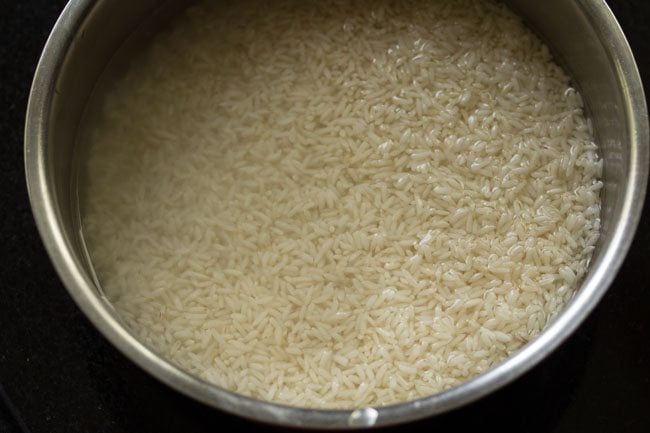
2. Then, pressure cook the rice with 2 cups water and ¼ teaspoon salt for 3 to 4 whistles or 11 to 12 minutes on medium heat.
You can also cook the rice in a pot. If cooking in a pot, then you may need to add more water. Depending on the quality of rice, you can cook for 2 whistles or 9 to 10 minutes.
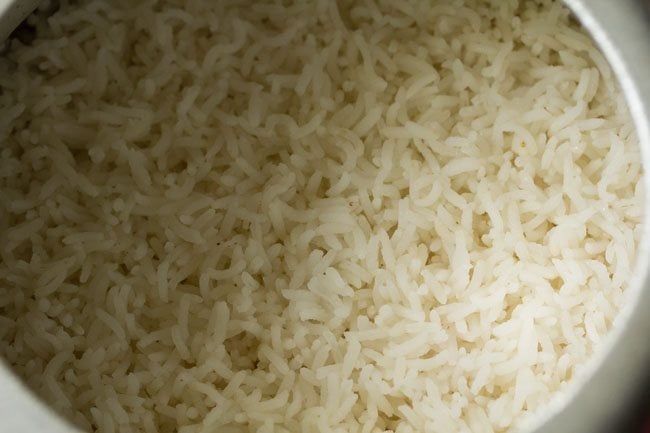
3. Soak ½ tablespoon tightly packed tamarind in ¼ cup hot water for 20 to 30 minutes.
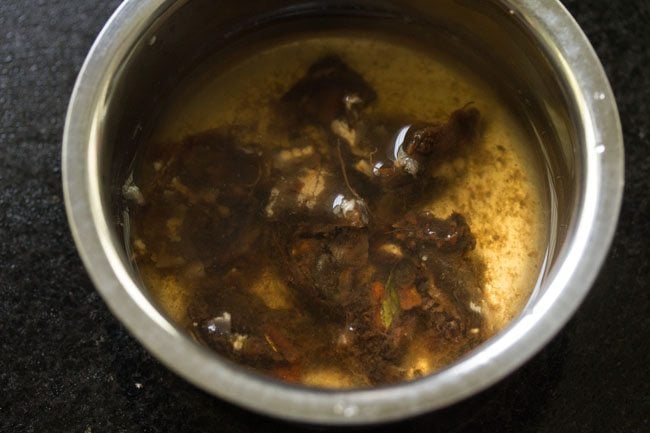
4. Later, squeeze the soaked tamarind in the water to get the tamarind pulp. Strain and keep aside.
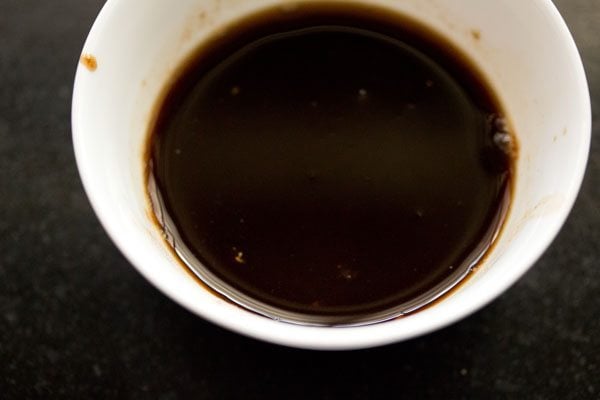
5. When the pressure settles down naturally, open the cooker’s lid and fluff the rice. You can let the rice grains to cool in the cooker itself or spread them on a large plate or tray.
Allow the cooked rice grains to become warm or cool down. Cover and keep so that the rice grains do not dry out. The cooked rice grains should be separate.
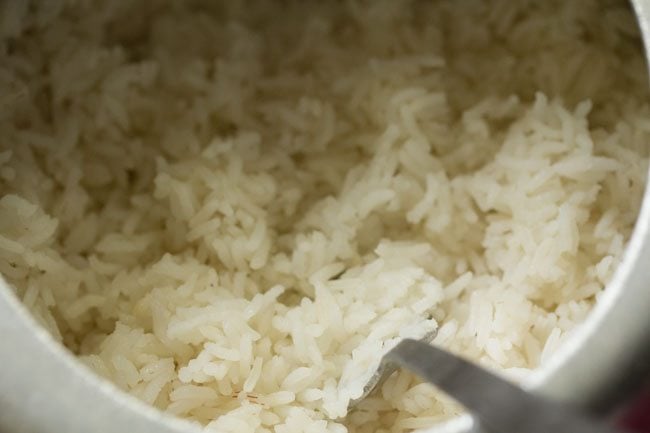
6. While the rice is cooking, rinse, remove the crowns of the eggplants/brinjals (vangi or baingan) and slice them vertically in 4 pieces.
As soon as you chop them, place them in a bowl containing water to which some salt has been added.
Do make sure that there is sufficient water covering the eggplants. Allow them to be in the salted water for 15 to 20 minutes.
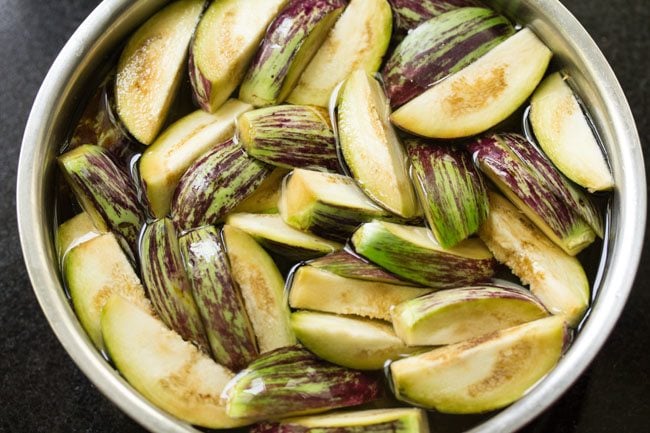
Make Vangi Bath
7. Heat 2 tablespoons peanut oil ( you can also use sesame oil or sunflower oil) in a pan or kadai. Add ½ teaspoon mustard seeds.
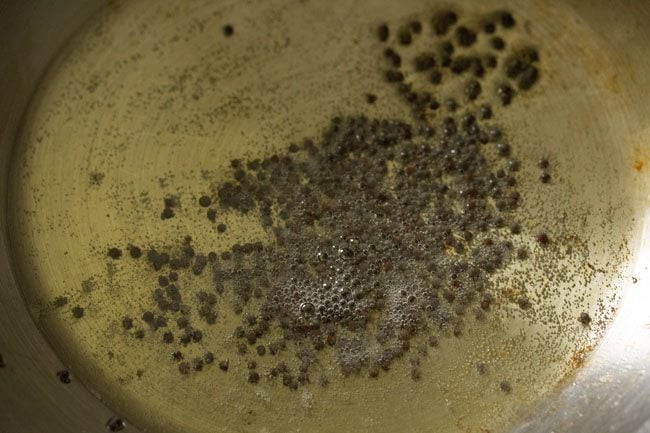
8. Once the mustard seeds begin to crackle, add ½ teaspoon urad dal.
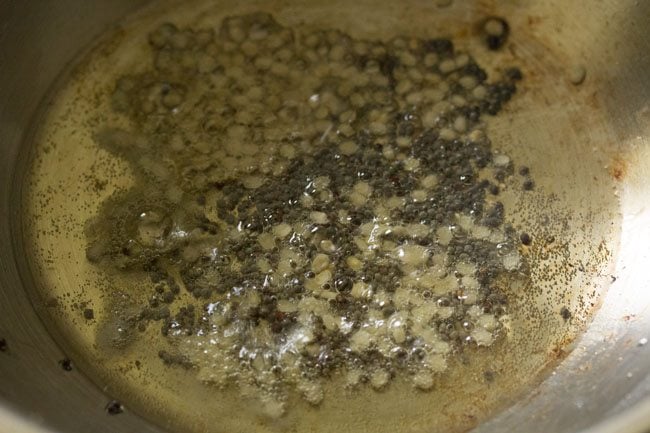
9. Next, add 2 tablespoons roasted peanuts or cashews.
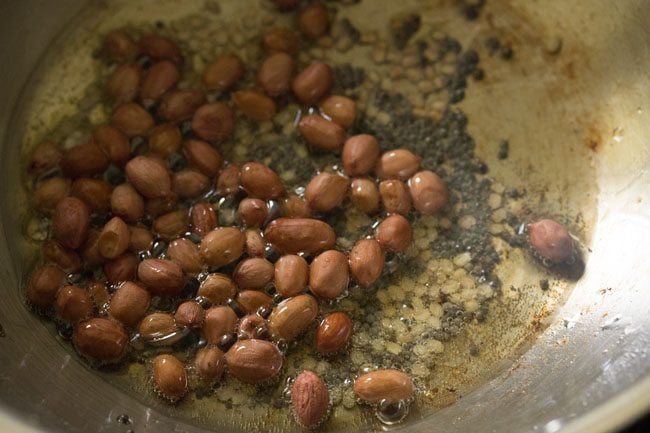
10. Sauté till the urad dal becomes golden.
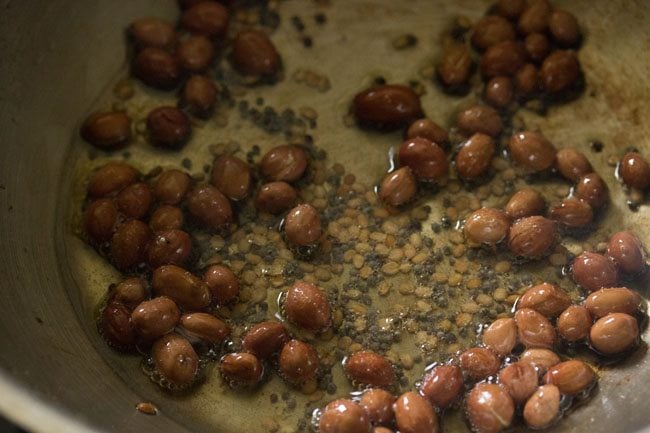
11. Next, add 1 to 2 dried red chilies, 1 sprig curry leaves or 10 to 12 curry leaves and ⅛ teaspoon asafoetida (about 2 pinches asafoetida).
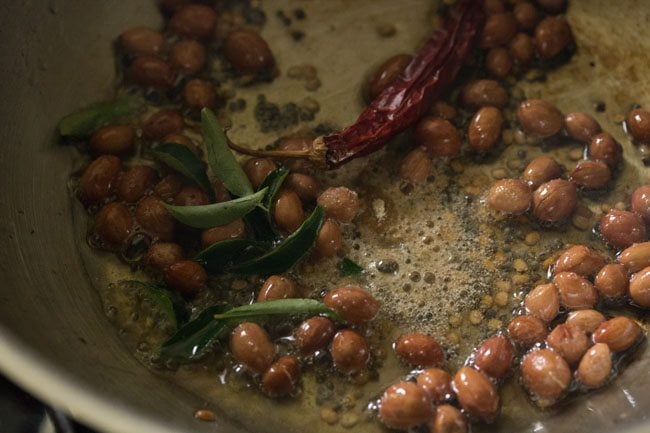
12. Add the eggplant pieces. Remove them from the salted water and add to the pan. Be careful as the mixture splutters when adding the chopped eggplants.
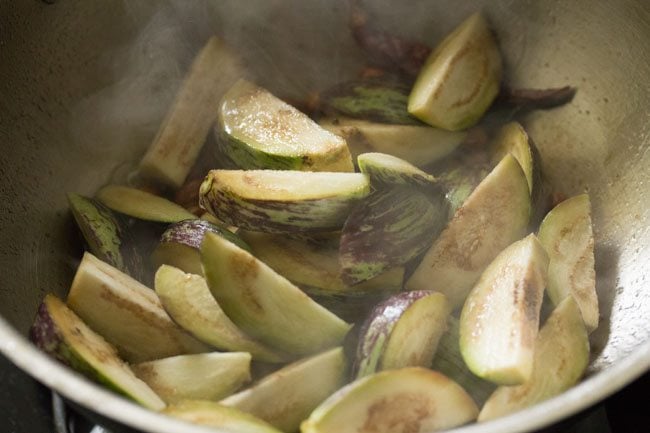
13. Mix them with the rest of the ingredients.
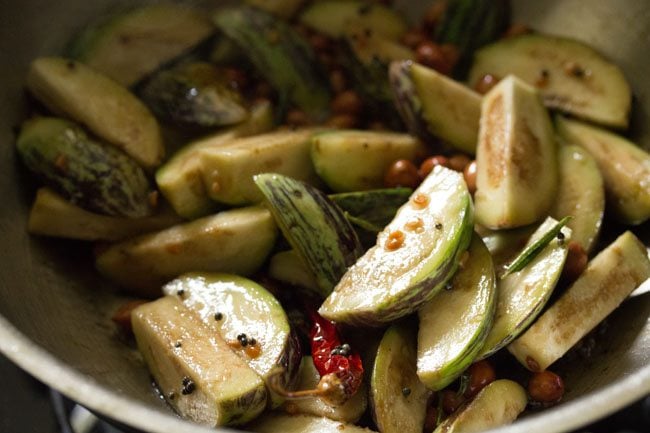
14. Add ¼ teaspoon turmeric powder and salt as per taste.
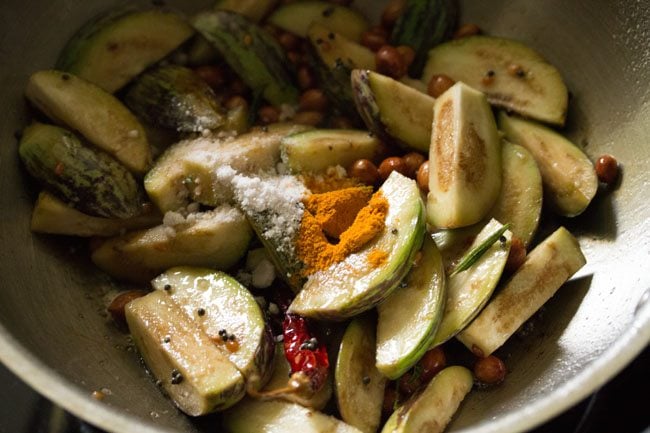
15. Mix the turmeric powder and salt very well.
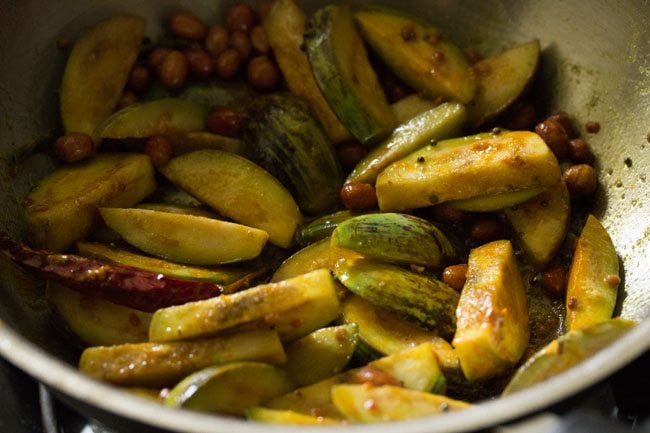
16. Cover the pan with a lid and let the eggplants get half-cooked. Check at intervals. If the eggplants start sticking to the pan while cooking, add some water. Then, cover and cook.
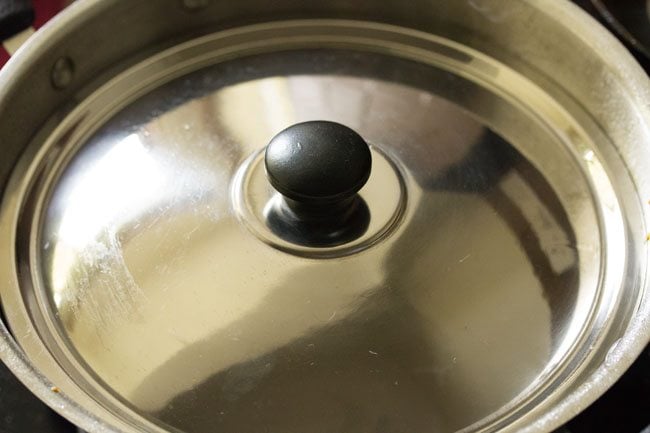
17. Half cook the eggplants.
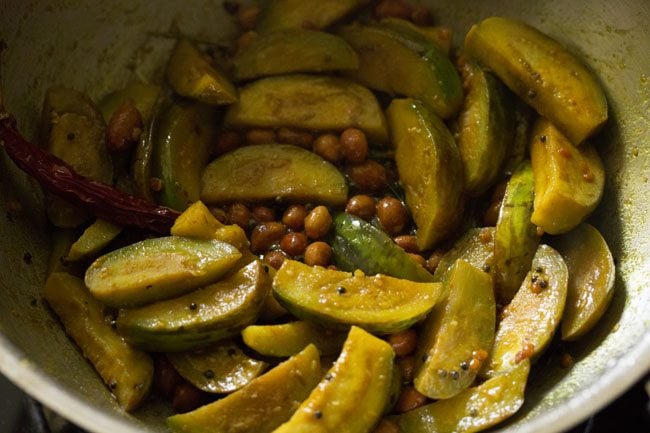
18. Once half done, add the tamarind pulp.
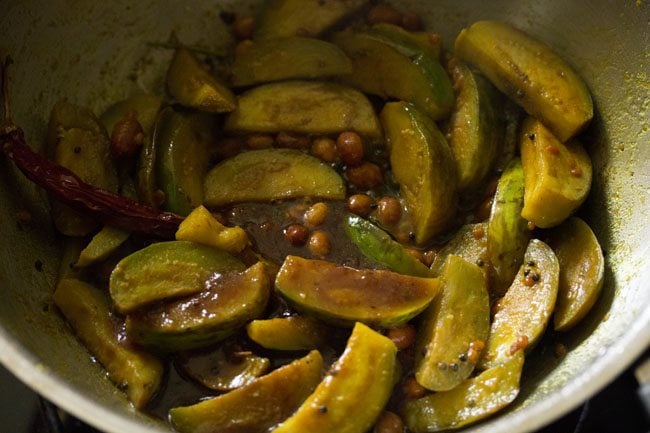
19. Then, add 2 to 2.5 tablespoons of the Vangi Bath masala powder.
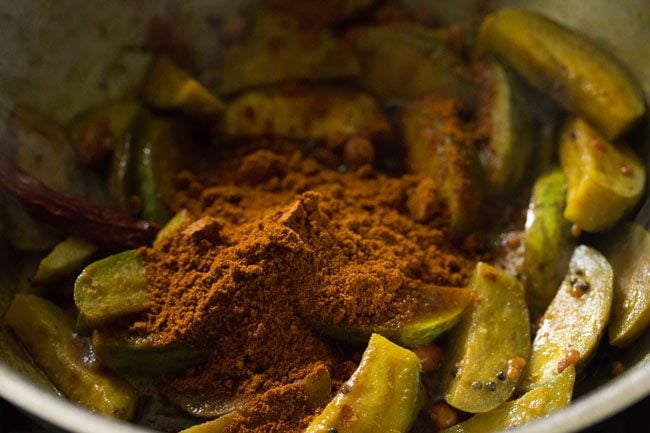
20. Mix well and continue to cook without the lid. If the masala along with brinjals/eggplants starts sticking to the pan, then add ¼ cup water and continue to cook.
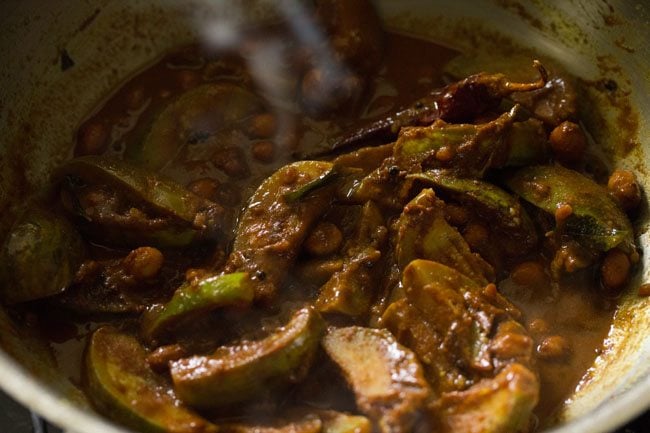
21. Once the brinjals are cooked well, add 2 tablespoons grated fresh coconut and ¼ to ½ teaspoon jaggery powder.
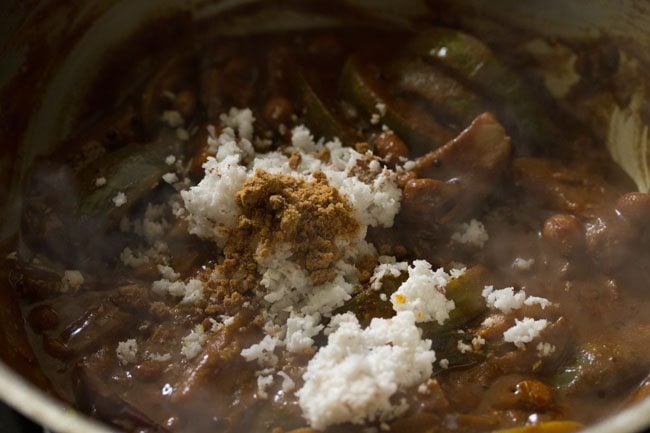
22. Mix well, once again. The brinjal masala is thick. But for some moisture you can have a semi gravy consistency in the brinjal masala. Check the taste and you can add some more jaggery powder or salt if you want.
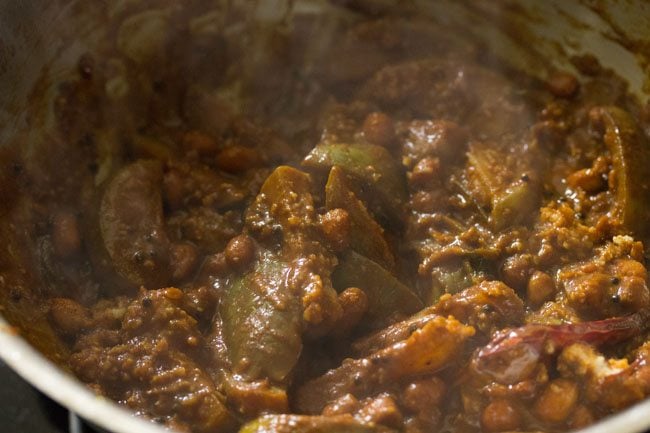
23. Remove the pan from heat and add rice in 2 to 3 parts. Mix gently.
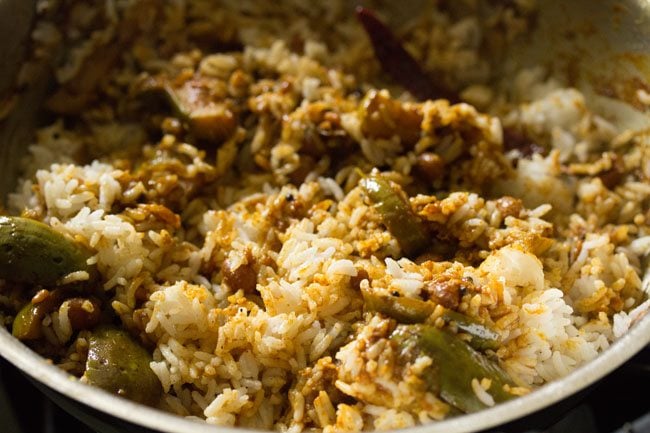
24. Add the next portion of rice and then mix well.
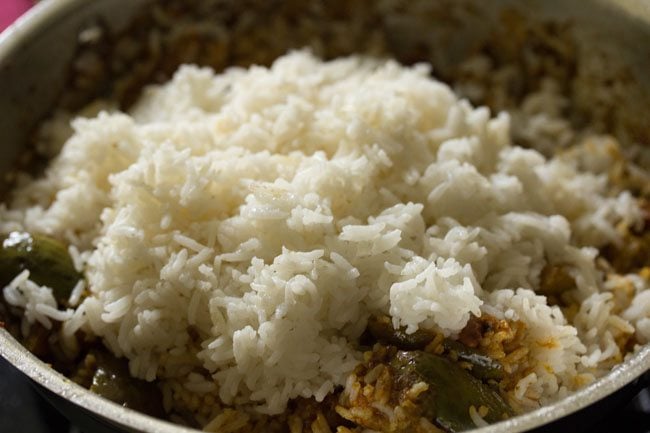
25. Stir gently, so that everything is mixed evenly.
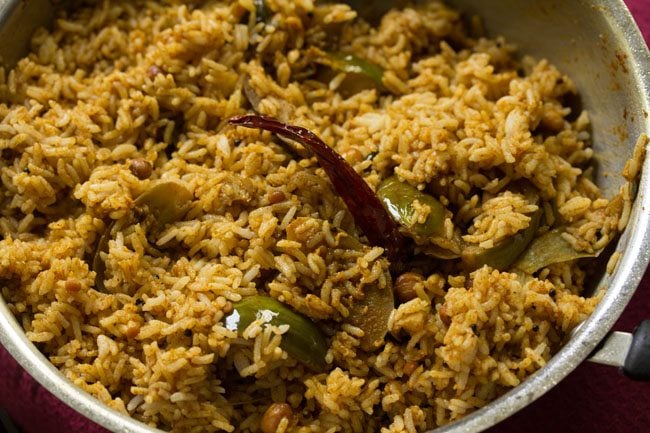
26. Serve Vangi Bath, Karnataka style with raita, papad or chips.
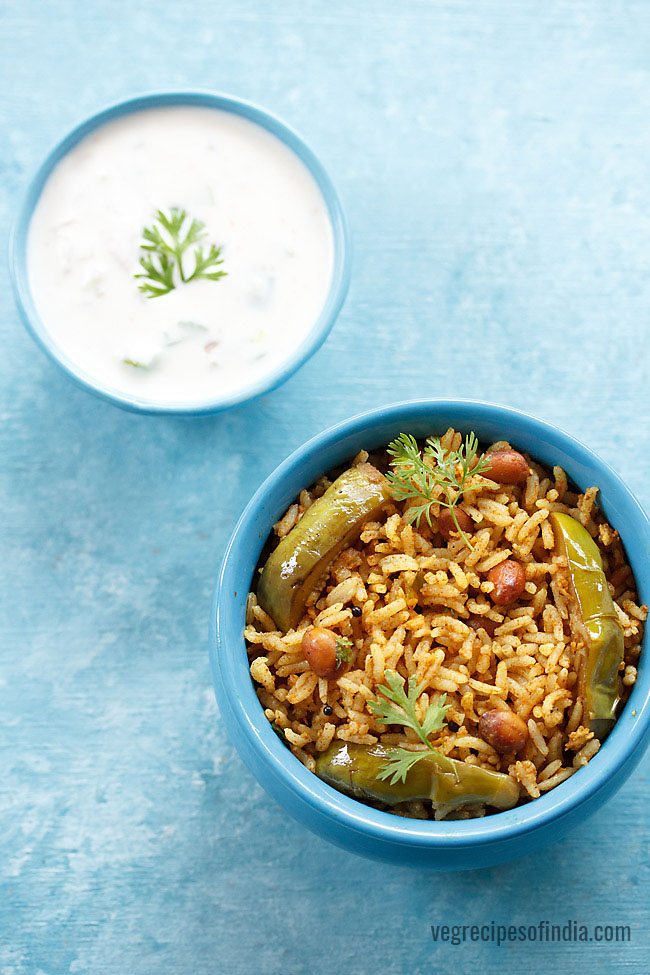
Expert Tips
- Brinjals: Similar to Maharashtrian style Brinjal Rice, selecting fresh and firm brinjals is key. The skin should be shiny and without blemishes. Wash, chop and soak in water to avoid discoloration till use.
- Rice: Use short-grain rice like sona masuri or any local rice variety for an authentic taste and texture.
- Homemade spice blend: Prepare the vangi bath masala powder at home for authentic flavor. If you can’t, then use store-bought one.
- Tamarind: Since tamarind is an integral part of this preparation, do not omit it. You can use readymade tamarind pulp, just dilute it a little in water before adding.
- Fats: If you wish to cook the dish in ghee over oil, do that.
- Nuts: You can skip adding the roasted peanuts or cashews. But adding them will enhance the flavor.
FAQs
While traditional Vangi Bath is made using local short-grain rice varieties like sona masuri, you can use basmati rice if you prefer. Just adjust the cooking time and quantity of water based on the type of rice used.
Yes, Vangi Bath is vegan. It typically is free of any animal products, as it primarily consists of rice, eggplants, spices and aromatics cooked in oil.
Traditionally, Karnataka style Vangi Bath is devoid of onion and garlic. But if you feel like adding them, you can. Sauté them well in oil. Adding these will also result in a flavor change.
Yes, you can make Vangi Bath ahead of time. Keep in an airtight container and refrigerate for up to 2 to 3 days. Reheat it gently on the stovetop or in the microwave before serving. However, a freshly prepared dish tends to have the best flavor and texture.
Please be sure to rate the recipe in the recipe card or leave a comment below if you have made it. For more vegetarian inspirations, Sign Up for my emails or follow me on Instagram, Youtube, Facebook, Pinterest or Twitter.
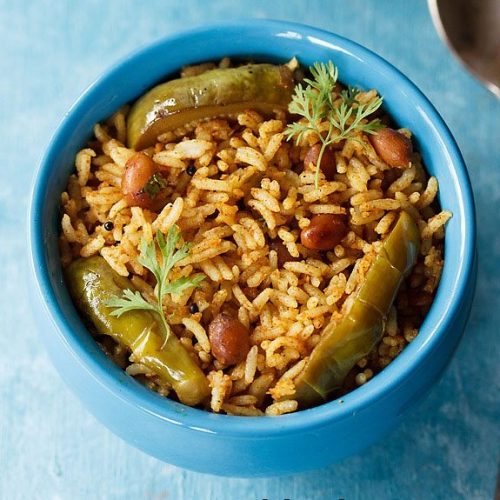
Vangi Bath Recipe (Karnataka Style)
Ingredients
For cooking rice
- 225 grams rice (sona masuri) or 1 heaped cup of rice
- ¼ teaspoon salt
- 2 cups water
For preparing tamarind pulp
- ½ tablespoon tamarind (tightly packed)
- ¼ cup hot water
Other ingredients
- 2 tablespoons peanut oil – can also use sesame oil or sunflower oil
- ½ teaspoon mustard seeds
- ½ teaspoon urad dal (hulled and split black gram)
- 2 tablespoons roasted peanuts or cashews
- 1 stalk curry leaves or 10 to 12 curry leaves
- ⅛ teaspoon asafoetida (hing)
- 1 to 2 dry red chilies (seeds removed)
- 200 grams eggplants (brinjal or vangi), small to medium-sized green or purple – cut in long pieces and soaked in salted water for 15 to 20 minutes
- ¼ teaspoon turmeric powder
- 2 to 2.5 tablespoons vangi bath masala powder
- salt as per taste
- 2 tablespoons coconut – fresh & grated, optional
- ¼ to ½ teaspoon jaggery powder or chopped jaggery
- 2 to 3 tablespoons coriander leaves – chopped), optional
Instructions
Preparation
- First soak 1 heaped cup rice in water for 30 minutes. Use any regular rice. I used sona masuri rice.
- Then pressure cook the rice with 2 cups water, ¼ teaspoon salt for 3 to 4 whistles on a medium heat or for 11 to 12 minutes. You can also cook the rice in a pot. If cooking in a pot or pan, then you may need to add more water.
- Soak ½ tablespoon tightly packed tamarind in ¼ cup hot water for 20 to 30 minutes.
- Later squeeze the soaked tamarind in the water to get the tamarind pulp. Strain and keep aside.
- When the pressure settles down on its own, open the cooker’s lid and fluff the rice.
- You can allow the rice to cool in the cooker itself or spread rice on a large plate/thali or tray. Let the cooked rice grains become warm or cool down. Cover and keep so that the rice grains do not dry out.
- When the rice is cooking, rinse the brinjals. Remove the crowns of the brinjals and slice them vertically in 4 long pieces. As soon as you chop them, place them in a bowl containing water to which some salt has been added.
- Do make sure that there is sufficient water covering the brinjals. Allow them to be in the salted water for 15 to 20 minutes.
Making vangi bath
- Heat the peanut oil (can also use sesame oil or sunflower oil) in a pan or kadai.
- Add mustard seeds.
- Once the mustard seeds begin to crackle, then add ½ teaspoon urad dal.
- Next add 2 tablespoons roasted peanuts or cashews.
- Sauté until the urad dal becomes golden.
- Then add red chilies, curry leaves and asafoetida.
- Add the eggplants or brinjals. Simply remove the brinjals from the salted water and add in the pan. Be careful as the mixture splutters when adding the brinjals.
- Mix them with the rest of the tempering mixture.
- Add ¼ teaspoon turmeric powder. Also add salt according to taste.
- Mix the turmeric powder and salt very well.
- Cover the pan with a lid and let the brinjals get half-cooked. Do check at intervals. While cooking, if the brinjals start sticking to the pan then add some water. Then cover and cook.
- Half cook the brinjals.
- Once they are half cooked, then add the tamarind pulp.
- Next add 2 to 2.5 tablespoons of the vangi bath masala powder.
- Mix very well and continue to cook without the lid. If the masala along with brinjals start sticking to pan, then add ¼ cup water and continue to cook.
- Once the brinjals are cooked well and tender, add 2 tablespoons grated coconut and ¼ to ½ teaspoon jaggery powder.
- Mix again very well. The brinjal masala is thick. But for some moisture you can have a semi gravy consistency in the brinjal masala.
- Keep the pan down and add rice in two to three parts. Mix gently.
- Add the first portion of rice and mix well. Then add the next portion of rice and again mix well.
- Mix gently but very well so that everything is mixed evenly.
- Serve Vangi Bath with raita, papad or chips.
Notes
- Try to make vangi bath with smaller or medium-sized variety of purple or green eggplants.
- Peanuts can be omitted or you can swap them with cashews.
- Make sure to use a good brand of vangi bath masala or add homemade vangi bath masala.
- Tamarind is one of the essential ingredients, so cannot be skipped. You can though substitute it with tamarind paste or sauce. Add accordingly and as needed.
- Feel free to use any non-sticky variety of short to medium grained rice to make vangi bath. If you have leftover rice, the recipe gets done quickly.
- Since this is a complex flavored recipe, it cannot be doubled as is. You have to adjust and balance the ingredients carefully when you scale the recipe up.
Nutrition Info (Approximate Values)
This Vangi Bath Recipe from the archives was first published in November 2016. It has been updated and republished in February 2024.
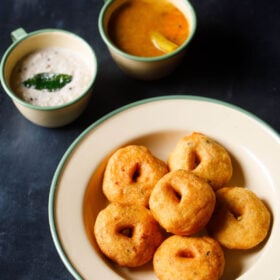
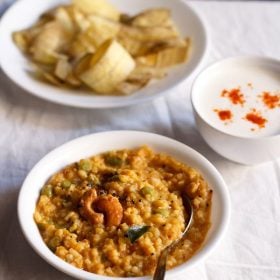
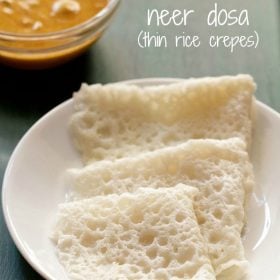
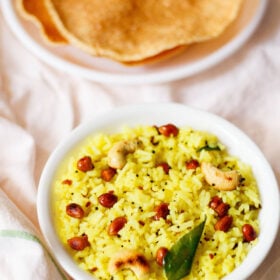








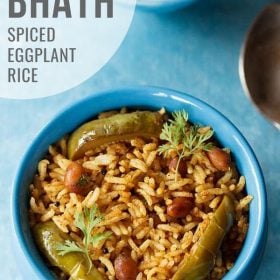
I just wanted to check if I am making it right and OLA !!! You gave the exact same recipe … I love vaangi bhaat, am going to make it right now .. thanks for being so precise .. keep it up ????????????????
thanks a lot brinda. happy cooking and i hope you like the recipe.
Well narrated recipe Dasannaavre. Dhanyabaadagalu. Will try today.
thanks arathi. do try the vangi bath and i hope you will like it.
Looks delicious.. When roasting peanuts, the flame is high or med-low? I assume they will absorb oil and get soggy if roasted at low flame
ruchi, the flame is medium-low or medium if using a thick bottomed pan. the peanuts do not absorb oil. if the oil is cold, then the peanuts absorb oil. here we are adding peanuts once the mustard seeds crackle. mustard seeds crackle in hot oil, so in this hot temp, the peanuts get roasted well. i had used a steel pan and its gets very hot even on low flame, so i have kept the flame to a low.
Thank you very clarifying. I’ll use this technique while making poha also then.
Is vangi bath masala same as goda masala?
welcome ruchi. both are different. vangi bath masala is from the karnataka cuisine. goda masala is from the maharashtra cuisine. the aroma, taste and flavor of both is totally different.
ok. do you make this masala at home? if yes, please do share the recipe if you find time. actually this past week we made the pav bhaji masala at home using the recipe that you have shared and it was amazing! We’ve already made pav bhaji twice over the week just because it tastes so good.
ruchi, i make goda masala at home as the quality of goda masala i get here is not at all good. there is no aroma and no flavor in them. vangi bhaat masala i have not yet tried at home. i got an organic pack of vangi bath masala and it was good. when living in bangalore also, i would buy vangi bath masala from outside. but i do plan to make one when this lot gets over.
thanks for letting me know about the pav bhaji masala. i still have this batch and i must have made pav bhaji many times with this masala recipe. a little is still left and that will also get over soon ?
very Nice
thanks nia.
can brinjal be substituted? with potato or cucumber etc?
you can use mix veggies like potatoes, cauliflower, carrots, beans and green peas. but just parboil them before you add in the gravy. you can also use potatoes only. with cucumber i am not sure how the texture of the veggie will be.